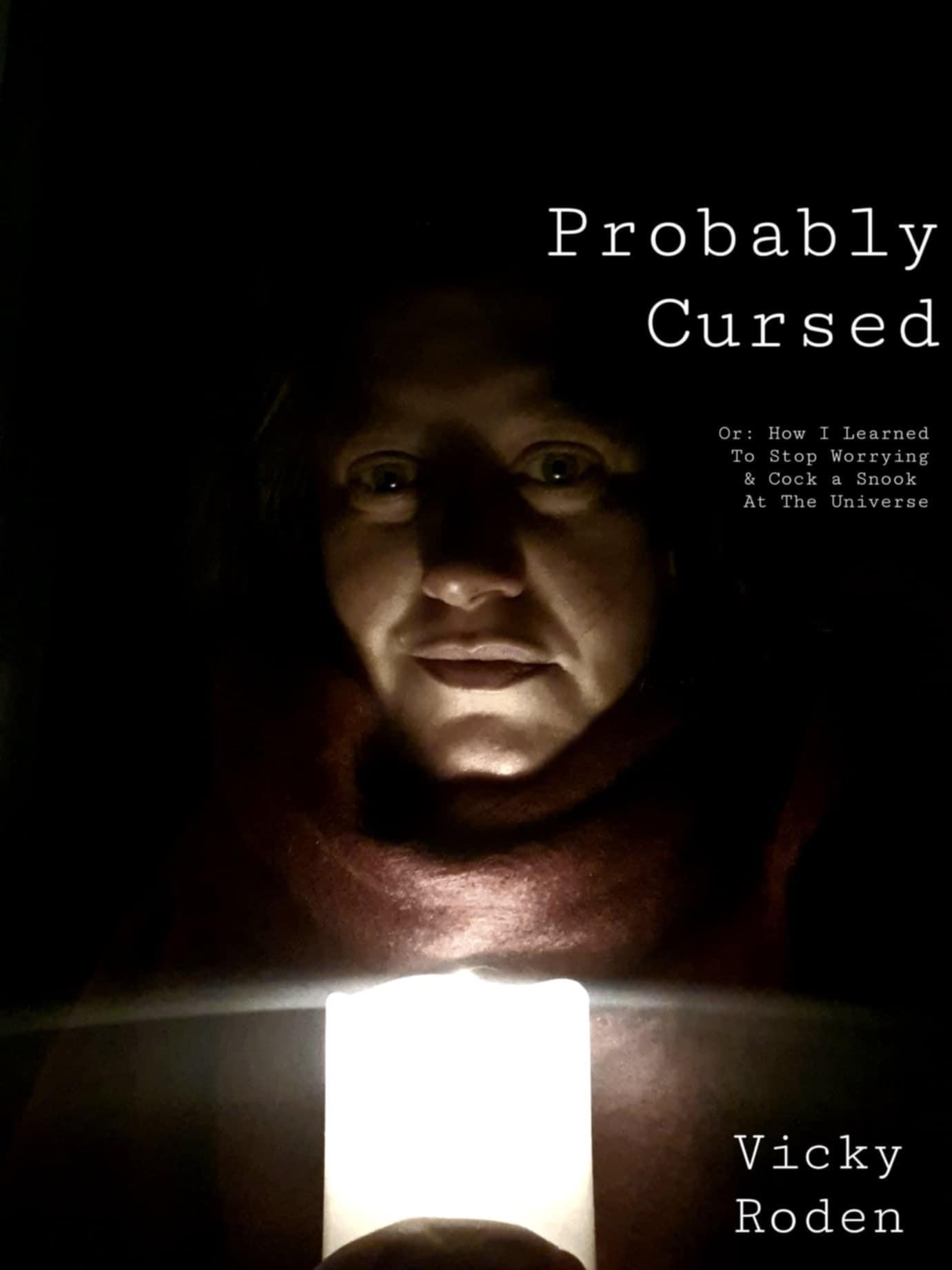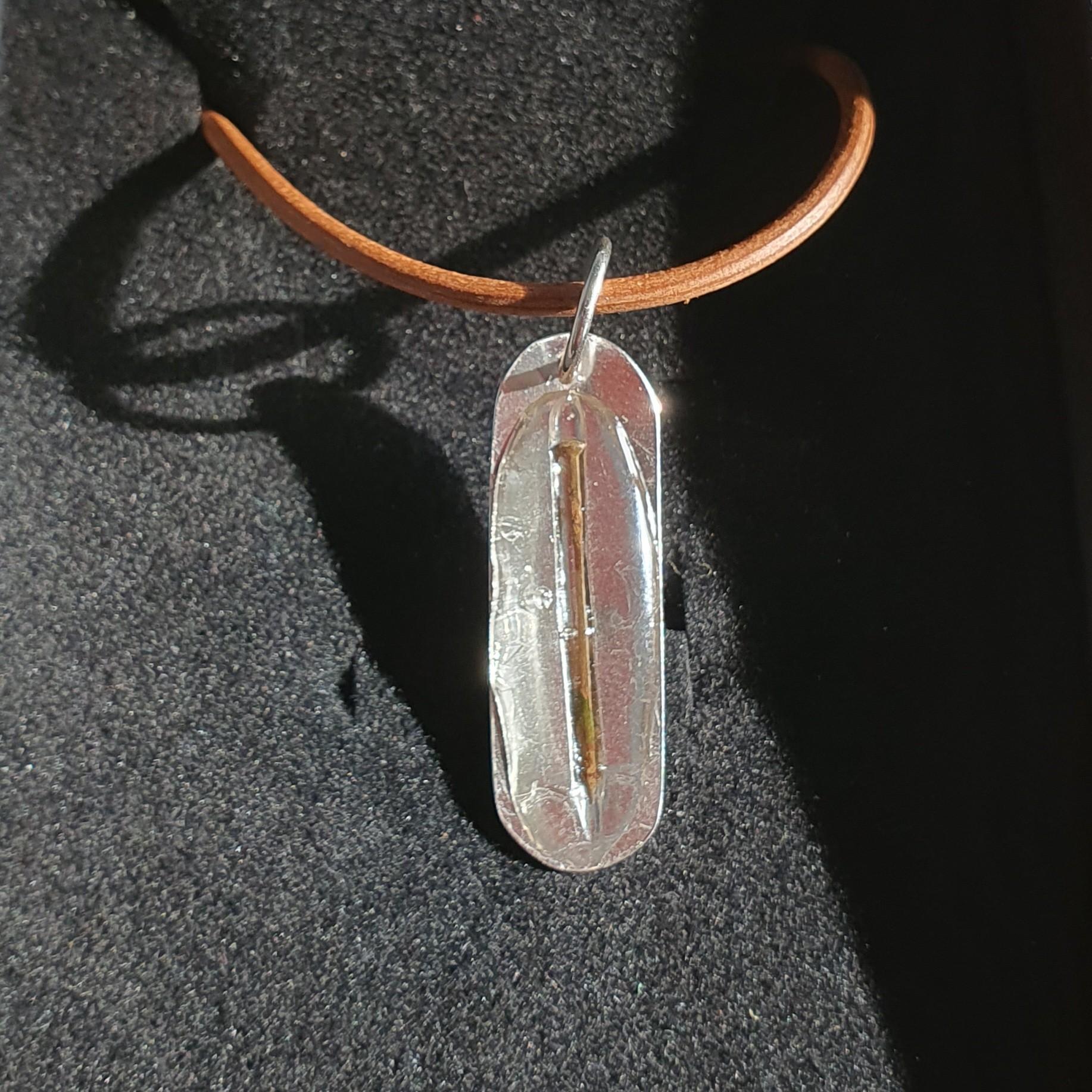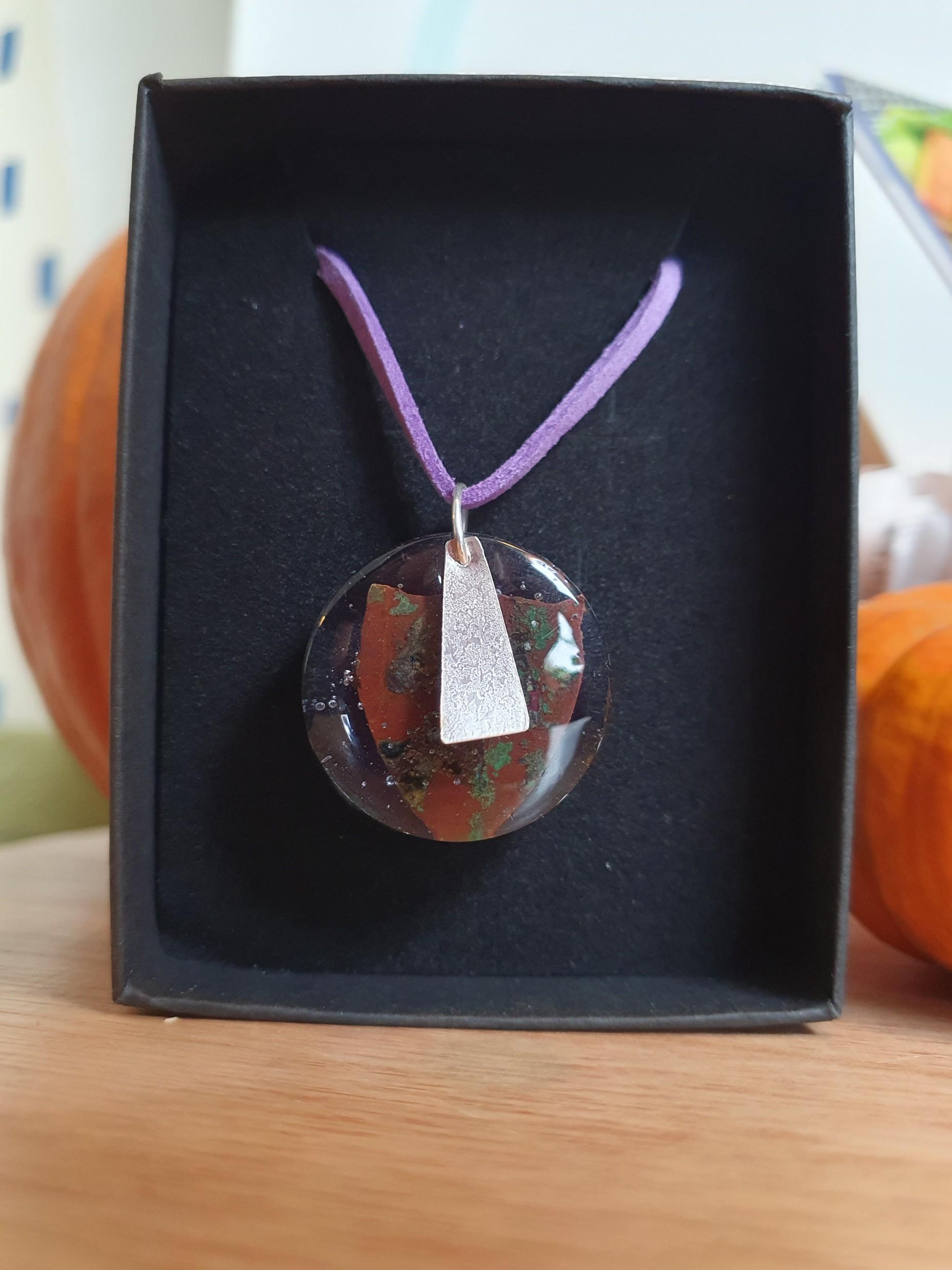
Part One
Probably Cursed
Or: How I Learned To Stop Worrying & Cock a Snook at the Universe
For Sarah Walden, Who was too damn good for this world.
This is a project that looks at curses.
Old curses, new curses, silly curses, potentially destructive curses… but specifically those objects that can hold curses.
We’re all encountered them – that porcelain cat in the charity shop that always seems to have you in it’s eyeline. The slightly distorted clown puppet that laughs randomly in the night even without batteries. The inherited brooch that really makes you feel your deceased grandmother’s fury that there’s no more biscuits left. All these things that are probably cursed.
Plus, sometimes a title is asking for trouble, and Probably Cursed is a project that’s seen misunderstood acrylic specs, burned fingers, lost pens, tiny flaws in printing and a display unit that’s doing a reasonable impression of a certain Pisa landmark. While this is likely a mix of Baader-Meinhof phenomenon and confirmation bias, it did feel like I’d inadvertently hexed myself with this project – a literal version of surprised Pikachu.
So this is my cocking of a snook at the Universe. Because if I’m cursing myself, I’m going to do the job properly.
Introduction
Probably Cursed was an attempt to do something light. Something fun. Something frothy that would lead to a specific commercial strand of my work.
I came into this residency from the relatively bleak deep dive into human remains in museum collections which was More Than Human, a project where I’d failed to anticipate the very real emotional impact the work would have on me. And I did it again – with my ruminations on the nature of curses and the cursed proving rather more intense than expected, and the handling of these objects and the feelings they brought up being more complex than originally intended.
I certainly never expected it to lead to any kind of writing.
And although the residency took me to places that were definitely dark, serious and still as a grave it also absolutely led me to unexpected joy, depth and a questioning of my own perceptions. This publication is a record of the project, the works created and the nature of curses and the cursed.
What Makes A Curse?
I’ve been obsessed with the notion of curses since childhood, mainly in respect of object of great power that carry consequences with their ownership. Probably the most widely known of these is the Hope Diamond, which has had a myriad of misfortunes laid at it’s feet up to and including the postman who handed the package over to the Smithsonian (apparently breaking a leg). The Koh-I-Noor diamond is also said to host misfortune for any man who wears it, and given the horrendous acquisition and absolute butchery of the gem I’m entirely approving of that fact.
That said, pretty much any substantial gemstones (being relatively physically small for their immense worth) will have an origin in blood and horror. Money brings out the worst in humanity, and gems see generations locked into slavery and obscene working conditions to this day – if you ever wanted an insight into the psyche of the owners of such mines take a quick glance at the Twitter* feed of Elon Musk, who grew up with emerald mine money and is thankfully actually subject to human rights laws that didn’t exist 200 years ago.
These stones are fundamentally cursed – but by the mania of those who seek to acquire and profit from them rather than any innate malevolence.
The definition of curses is also surprisingly broad –from the act of wishing harm on someone, an archaic term for the perfectly natural process of menstruation (after the curse laid on Eve by a loving God for defying him), vulgar language intended to hurt, to ANY emotional or personal attribute which isn’t useful in a particular scenario.
As someone who is coming to terms with her own neurodiversity the word ‘cursed’ crops up a lot, with many historic references to characters labouring under a curse that, to modern sensibilities, is simply a description of neurospicy traits. I’m all too aware that a century ago my own inclinations would have likely seen me institutionalised, exorcised, or kept in the attic. Head back a little further and I’d have been in line for the gallows whenever there was a witch hunt. But those brooding anti-heroes who shun the brightly lit and noisy balls (preferring the solitude of the moors) and beautiful yet broken maidens who obsessively sew, blinded to the attentions of those who seek their favour are
both tropes that are inferred to be cursed for their inability to exist as others do. For not wanting that which others want.
My own experience growing up was to have a constant sense that I was somehow fundamentally wrong – not in my parents eyes, but in the eyes of my teachers and peers. In the 1990’s the popular concept of neurodiversity was strictly limited to Autism Spectrum Disorder, and more generally the events of Rain Man (1988). I very much felt that I was, somehow, cursed – not to transform on a full moon, or be assaulted by spectral hounds upon inheriting an estate from an unknown relative, but to be somehow flawed in how I related to the world and what I wanted from it. Happily, greater understanding of neurodivergence and the fact it is now an open discussion rather than a secret shame is leading to many more people getting the support and understanding they need to feel more comfortable in their own heads.
So while the me that existed in 1612 may have been first in line for witch hunt questioning, and the me that exists now may have had a harder time understanding her existence than she strictly needed to, a future me would be able to
understand that this difference is entirely normal, natural and not to be feared.
This is how curses are broken.
* Yes, I know it’s had it’s name changed. I’ll stop deadnaming Musk’s pet project when he stops deadnaming his daughter.
What Makes An Object?
“Today a young man on acid realised that all matter is merely energy condensed to a slow vibration. We are all one consciousness experiencing itself subjectively, there is no such thing as death, life is only a dream and we are all the imagination of ourselves...”
Bill Hicks
Psychometry is the theory that objects pick up and hold our energies and emotions. It crops up constantly in popular culture and is a staple of psychic entertainment – holding an object which belonged to a departed loved one is often the first action of those seeking to contact the dead.
The concept of objects being containers for ‘energies’ is an ancient one, and a fundamental basis for cursed objects. The pain and misery associated with the acquisition of gemstones seeping into their crystalline structures is an alluring thought, and the notion that a little of a relatives love and spirit still resides in their favourite ring or kitchen knife allows us to feel a connection with those have passed on.
Then there are those objects which, through age or love, develop their own soul. The Japanese folkloric concept of Tsukumogami asserts that once an item becomes a hundred years old it gains a soul or can become possessed by a spirit. Frequently these can be malevolent, particularly where the objects owners attempt to destroy it ahead of its centenary to avoid the possession. Strong love for an object can also lead to the acquisition of a spirit or soul.
Probably Cursed very much relies on the assertion that these objects can hold on to echoes of the past, have a memory of their own and will, one ring style, nudge their owners into situations where the object has an element of autonomy. This base premise of Psychometric Energy Transference (working from the perspective of it as a potential contaminant you can’t rule out) suggest an object, by virtue of it’s circumstances, having a higher than average possibility of displaying cursed attributes, including:
1: Objects belonging to a deceased individual or related to their death.
2: Extremely old objects.
3: Objects which have been through a lot of hands or have touched many lives.
4: Objects found 1-100 plus years after having been lost, particularly when they are separated from the rest of existence.
5: Objects specifically collected/created to manifest specific metaphysical traits.
6: Stuff that just generally strikes you as odd.
For me, these fall broadly into three categories: Foundlings, heirlooms and mythic.
As you might expect, Foundlings are found objects. More specifically, found objects which were picked up from the floor, whether that be the Thames foreshore (mudlarking), buried in a field (metal detecting), or picked up on a beach (beachcombing). These objects are usually lost or intentionally discarded, and frequently have spent years quietly existing in the dark before they are unearthed.
Beachcombing has always been a popular activity, while metal detecting began in the late 19th century but began to boom in the 1970’s when more portable and sensitive detectors came on the commercial market. Mudlarking, once seen as the last resort of London’s poorest communities, has experienced a massive surge in popularity over the past twenty years – to the extent that the Port of London Authority has seen demand for licences rise from 200 to 5000 a year in this time and is now planning to pause issuing them to preserve the archaeological integrity of the foreshore.
These objects hold a particular romance for me – lost to the mud and murk before emerging into the light in an entirely new era. It’s a form of
time travel, and while they are rarely unscathed for their experience the breaks, cracks and rust tell their own stories. This is no longer a pin badge, it’s a relic with a few legible letters. This is not just a rusted pin, but a fixing that could have held together the costume of a Tudor queen.
These items speak of a tangible history that makes our ancestors relatable people rather than flat figures in history books. A child played with their tin soldiers in this field. A woman dropped a pin disembarking a boat on this jetty. There’s a particular romance to seeing the physical proof that humans have been doing the same stuff for centuries.
As their name suggests, heirlooms are inherited. Sometimes this happens directly, but most of the time heirloom items are bought from charity shops, car boot sales and flea markets. Essentially my definition is something that belonged to somebody else that was not discarded as broken. Charity shops are especially good for this – they’re often the first port of call for people coping with a loss in the family, and you can often see whole lives and personalities on display
The heirloom is also one of the most obvious candidates for a cursed object, and anyone who has been through a particularly tricky family probate situation can attest to how this process can make people act as tough they’re possessed by a malevolent force.
I have an ongoing project of heirlooms, specifically abandoned photographs, called The Family McTurk. The name comes from another heirloom object, namely several books I got from a shop in Hereford which (I discovered when I got home) had all been in the collection of a Mary McTurk over a span of about 40 years. The same trip I’d also picked up some 1920’s
holiday snaps, and I started to jokingly refer to them as Mary’s (That’s Mary McTurk and her favourite nephew, that’s Mary McTurk and that cousin that annoys her…). The photos I collected often broke my heart a little – these were people who existed, who were loved, and now they’d been separated from their descendants and were unknown. The Family McTurk was an attempt to give these individuals a new community to be celebrated within – although I may never know who they were or what they loved I can at least treat this particular proof of their existence with care and through exhibitions let other people look at their faces.
This category of object also allows, in respect of the Probably Cursed residency, for me to include the personality traits of the original owner in the probable curse the object holds. I’ve used this to help process my own grief in the past as a way of commemorating the quirks of lost loved ones.
This category refers to those items that are innately mythical or magical. Four leaf clovers, horseshoes, hagstones, and items that have been specifically crafted to have specific effects.
The allure of a mythic item is great – anybody who plays Dungeons & Dragons, Elder Scrolls or anything similar knows that rush when you pick up an enchanted object that grants you particular abilities.
There are always items that already have potential metaphysical potential in this way, but then there are the objects made from scratch. Much of these processes rely on historic symbolism and folk tales – the ink made for The Souling includes purple sage, said to bring enlightenment and wisdom, and lavender, which represents love and healing. Then there are metals such as silver - sacred to Artemis and with a long history of warding off werewolves and vampires, copper - is said to ground us and connect us to the earth, and iron - protects against witches and the fey.













